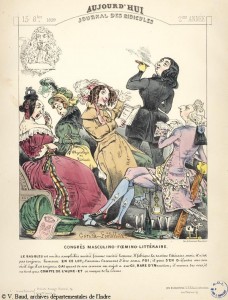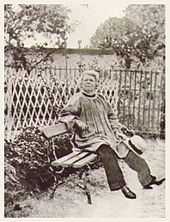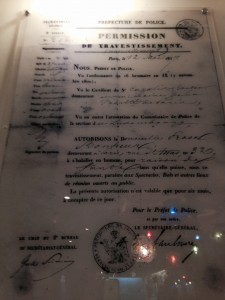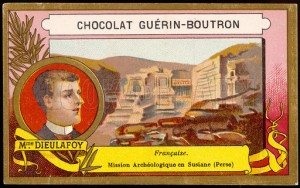By Rachel Mesch (Regular Contributor)
On November 7, 1800, the prefecture of police for the city of Paris issued an order prohibiting women from wearing men’s clothing in public. Noting that many women cross-dress but not for (excusable) health-related reasons, and that this behavior was a danger to themselves and others, the city order declared that “any woman who wishes to dress as a man,” (toute femme désirant s’habiller en homme) must present herself to the prefecture for authorization. In order to do so, she would need the notarized signature of a health official declaring the medical necessity of this change in wardrobe—the only accepted criteria for such permission—as well as signatures of government officials. Henceforth, any cross-dressing women without proper documentation risked being arrested.
This law remained in effect in Paris for 213 years.
In the first instance, female revolutionaries, who had demanded freedom of dress and the right to wear pantaloons, likely prompted the need for the ordinance—which was dated as “16 brumaire of the year IX,” in the idiom of the short-lived Republican calendar (created to erase any traces of the ancien régime and abandoned upon Napoleon’s defeat). But as the century progressed, the targets of this law shifted, while the policing of gender transgressions remained real. In 1853, as writer George Sand was regularly caricatured for her manly attire, a law against cross-dressing was added to the Penal Code, forbidding cross-dressing at balls and public spaces; in the 1880s, as young women entered increasingly public roles, the police issued circulars and reminders that the law against wearing pants was in still in place; in a loosening of the law in 1909, women “holding by hand bicycles or the reins of a horse” were granted special permission to go out in public “en culotte.”
It’s unclear exactly how many women secured the permit over the course of the century. As historian Christine Bard has documented, the archives of the Parisian prefecture are frustratingly idiosyncratic, making it difficult to come to any general conclusions. But the documents therein are hardly uninteresting.
The health requirement seems to have been loosely defined at best. The first permit—from 1806—allowed Catherine-Marguerite Mayer to wear pants in order to ride her horse. A certain Mademoiselle Foucaud acquired the permit a few decades later in order to get a printing job reserved for men, which she had discovered paid better. A clipping from a 1911 newspaper preserved in the archive suggests that she was not alone: several women had permits allowing them to pass as men professionally. Indeed, in addition to the increased comfort and agility that pants allowed (the alternative, especially in the second half of the century, being the waist-squeezing corset), wearing men’s clothing paid dividends: not only could women hold men’s jobs, but they saved money on clothing that was less expensive and lasted longer. While financial necessity seemed to inspire some requests, others were granted to women whose appearance had a naturally “masculine look.” Allowing them to wear pants was seen as protecting them from the prying eyes of an unsympathetic public.
Hardly a trace can be found in these archives of the most famous female pants-wearers of nineteenth-century Paris—those who wore pants without permits (George Sand)—nor those we know to have procured them: the writer Rachilde, the explorer Jane Dieulafoy, or the painter Rosa Bonheur. Fortunately, they left behind other clues to their sartorial challenges.
The café named for Bonheur in Paris’s nineteenth arrondissement—a trending Parisian hot spot tucked in the Buttes de Chaumont park where a campy chorus sings each Sunday evening—displays her permit on the wall. Citing the original ordinance, it authorizes Bonheur to “dress as a man” as of May 12, 1857, to be renewed every six months. The form lists “health reasons” in the appropriate slot (interesting in itself, suggesting that there were reasons allowed beyond medical ones) and notes that this release does not apply to “shows, balls, and other meeting events open to the public.” And there were health reasons of sorts: Bonheur wore pants and heavy boots to navigate the farms where she painted the animal tableaux that gained her fame. But her pants-wearing was also linked to a progressive gender expression, matching her closely cropped hair. She lived on a farm with her lover Nathalie Micas, whose family had taken her in as a young girl. A beloved figure, in 1865 Bonheur was awarded the Legion of Honor for her acclaimed work, and is widely considered the most influential woman artist of the nineteenth century.
While we don’t have her actual permit, we do have Rachilde’s letter of application, in which she claimed that she needed to wear pants to practice as a journalist (as writing books, she lamented, don’t pay the rent). But the plea for pants is not a request to be allowed to pass as a man; rather, she wanted to be able to stand out, because “in journalism, originality is a must.” In the letter (which, incidentally, was unsuccessful, but a permit was later granted), Rachilde reminds the prefect that she is the author of the scandalous novel Monsieur Vénus. In that novel, cross-dressers abound, as protagonists Raoule de Vénérande and Jacques Silvert delight in switching gender roles in order to shock and confound friends and family. Already in the 1880s, Rachilde understood gender as performance; she also shifted her own performance of gender and stopped wearing pants after her reputation as an “original” had been secured by the 1890s and she married fellow writer Alfred Valette.
Finally, one of the most famous cross-dressers of the century’s close was the intrepid archaelogist-explorer-writer Jane Dieulafoy, who had begun wearing pants when she rose to battle with her husband Marcel during the Franco-Prussian war. She resumed this practice on her travels with him to Persia and later to Baghdad, and secured the required permit when they settled in Paris in the 1890s. Dieulafoy never wore women’s clothing again, and was frequently mistaken for a man. Like Bonheur, she was a beloved figure, awarded the Legion of Honor and considered a testament to the very honor of France.
Taken together, these brief portraits suggest that the ways in which women expressed their gender in nineteenth-century France—a time of rigid gender bifurcation—could be unexpectedly diverse, and that women’s motivations to dress in non-traditional ways were multiple and fluid. Women wore pants in the nineteenth century to earn better wages, to participate fully in certain activities, to hide from sight, to attract attention, to express their sexuality, to advocate for feminist rights, to rebel, to shock: in other words, to express themselves. And as the examples of Bonheur and Dieulafoy demonstrate, not all of these women were shunned—though many were.
In 2013, the law of 1800 was finally repealed. The minister for Women’s Rights, Najat Vallaud-Belkacem, who headed the initiative, described the law as incompatible with French values of equality, concluding: “The document is nothing but a museum piece.” It’s worth noting, though, that if you google Vallaud-Belkacem, you will find far more about her own fashion choices than you will about this important work in closing an unfortunate chapter in the policing of French women’s clothing.
Further reading:
Bard, Christine. “Le ‘DB58’ aux Archives de la Préfecture de Police,” in Bard and Nicole Pellegrin, ed. Femmes travesties: un “mauvais” genre. Spec. issue of CLIO. Histoires, femmes et sociétés 10 (1999): 1-20.
Hawthorne, Melanie. Rachilde and French Women’s Authorship: From Decadence to Modernism. Lincoln: U of Nebraska P, 2001.




